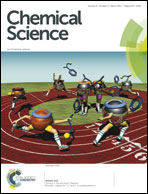Chiral hemicucurbit[8]uril as an anion receptor: selectivity to size, shape and charge distribution†
Abstract
A novel eight-membered macrocycle of the hemicucurbit[n]uril family, chiral (all-R)-cyclohexanohemicucurbit[8]uril (cycHC[8]) binds anions in a purely protic solvent with remarkable selectivity. The cycHC[8] portals open and close to fully encapsulate anions in a 1 : 1 ratio, resembling a molecular Pac-Man™. Comprehensive gas, solution and solid phase studies prove that the binding is governed by the size, shape and charge distribution of the bound anion. Gas phase studies show an order of SbF6− ≈ PF6− > ReO4− > ClO4− > SCN− > BF4− > HSO4− > CF3SO3− for anion complexation strength. An extensive crystallographic study reveals the preferred orientations of the anions within the octahedral cavity of cycHC[8] and highlights the importance of the size- and shape-matching between the anion and the receptor cavity. The solution studies show the strongest binding of the ideally fitting SbF6− anion, with an association constant of 2.5 × 105 M−1 in pure methanol. The symmetric, receptor cavity-matching charge distribution of the anions results in drastically stronger binding than in the case of anions with asymmetric charge distribution. Isothermal titration calorimetry (ITC) reveals the complexation to be exothermic and enthalpy-driven. The DFT calculations and VT-NMR studies confirmed that the complexation proceeds through a pre-complex formation while the exchange of methanol solvent with the anion is the rate-limiting step. The octameric cycHC[8] offers a unique example of template-controlled design of an electroneutral host for binding large anions in a competitive polar solvent.
![Graphical abstract: Chiral hemicucurbit[8]uril as an anion receptor: selectivity to size, shape and charge distribution](/en/Image/Get?imageInfo.ImageType=GA&imageInfo.ImageIdentifier.ManuscriptID=C6SC05058A&imageInfo.ImageIdentifier.Year=2017)


 Please wait while we load your content...
Please wait while we load your content...